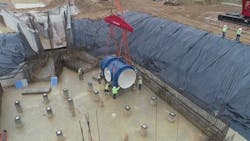Luce Bayou Interbasin Transfer Project
Cost: $318 million
Location: Harris County & Liberty County, Texas
Year: 2020-12-31
Size: 240 mgd per day system
Owner: Coastal Water Authority
Designers: BGE Inc.
Contractor: Thalle Construction
To meet an anticipated demand increase while also shifting to use surface water in Texas, the Luce Bayou Interbasin Transfer Project (LBITP) aimed to transfer existing surface water rights held by Houston, Texas, in the Trinity River to Lake Houston in the San Jacinto basin.
The LBITP is a $318 million water supply project that included a 500 million gallon per day (gpd) pump station, approximately 3.6 miles of pipeline, a setting basin and maintenance facility, and 23 miles of open canals to convey the untreated water to an outfall structure at Lake Houston.
The Coastal Water Authority in partnership with the city of Houston, initiated the LBITP to reduce groundwater dependency in the greater Houston area. Due to excessive pumping of groundwater, much of the ground surface in Texas has subsided or sunk. As a response, Texas wanted to shift its source of water from groundwater to surface water.
The West Harris County Regional Water Authority and the North Fort Bend Water Authority, in partnership with the city of Houston, constructed the Surface Water Supply Project to convert from groundwater wells to surface water to comply with subsidence district requirements.
According to the team, the goal is to have a 60% reduction of groundwater usage by 2025 and an 80% reduction of groundwater usage by 2035. According to the 2011 State Water Plan, more than 9 million people will be utilizing the benefits from the LBITP by 2060.
There are no conveyance facilities that provide raw Trinity River water to the Northeast Water Purification Plant (NEWPP), which treats water from Lake Houston. Due to this, and because studies have shown that Lake Houston and NEWPP cannot meet future water demands for the Houston area as it continues to grow, the project will connect the raw water delivery with treatment capacity to the water supply for the region.
As a result of this project, more than 300 water districts and city customers in the northern and western Houston metro area and northern Fort Bend County will experience the benefits of treated water.
One of the key components of this project is the pig retrieval station used for regular maintenance on the pipelines to combat zebra mussels in the water supply. The pig retrieval station required installing 3 miles of dual 96-inch water transmission lines and the pigging retrieval station. These components, however, needed to withstand day-to-day operations and also accommodate the settlement presented by the terrain.
BGE Inc., the project designer, faced the challenge to reduce the footprint of the pigging station, so the team had to design a plan that was conducive to shortening the downtime of the routine system maintenance or the time needed to deal with the issues caused by zebra mussels.
BGE Inc. overcame this obstacle by initiating conversations with Victaulic to provide a full system solution. Along with the facility owner—Coastal Water Authority—BGE Inc. and Victaulic streamlined the development of the system.
The first step in designing the system was to ensure it would accommodate thermal expansion and contraction inside the station as well as differential settlement. BGE Inc. selected the Victaulic Style W257 Dynamic Movement Joint, which is designed to address the differential settlement challenges present at the station.
By using grooved technology at the pigging retrieval station, BGE Inc. successfully reduced the pigging station’s footprint. The flexible couplings are designed to absorb the forces on the pigging system so the valve vault size reduction was achieved.
Overall, the team was able to achieve 4 inches of settlement in approximately 22 feet on this installation by using the joints. Additionally, the couplings provided quick and easy entry to access the isolation systems, as well as the clean out and retrieval areas. When the system is running, the products can be maintained easily with minimal disruption to operations and without introducing unnecessary risks for maintenance workers.
Every job site faces the challenges and risks associated with creating and maintaining a safe work environment. For the LBITP, Thalle Construction wanted to reduce these risks on site. The grooved technology provided a simplified construction methodology, which minimized risks to installers. Workers were able to carry out the installation without specialized tools because the joints are self-aligning. It was easy for the installers to form a joint and to see the metal-to-metal bolt pad contact once the placement was complete, as well.
All of these factors allowed Thalle Construction to deliver the critical pig retrieval station, which accommodated the forces and differential settlement, achieved the necessary footprint reduction, minimized safety risks, and provided reduced downtime for routine or untimely maintenance. Through the combined partnership efforts of all parties involved, the challenges were overcome and the ability for future expansion is now made easier.


